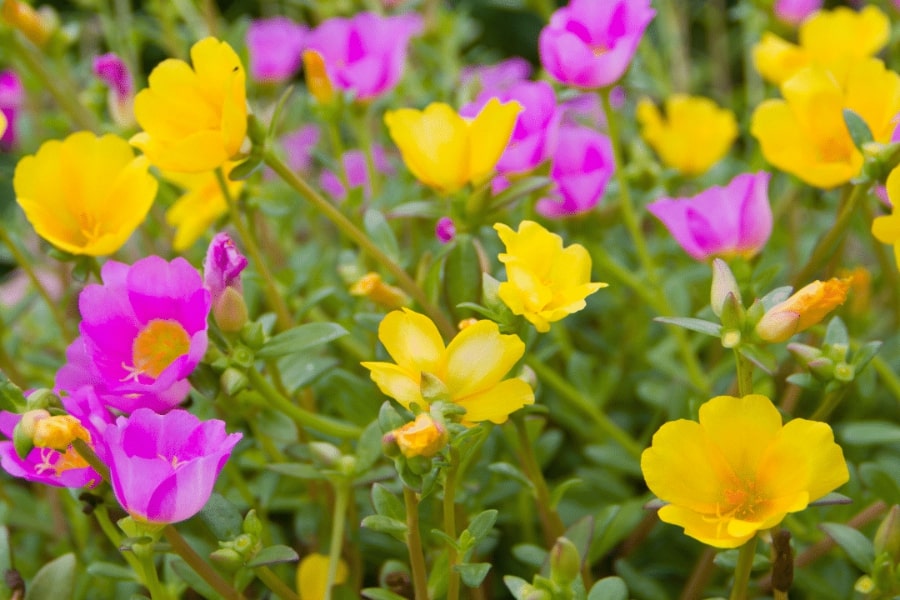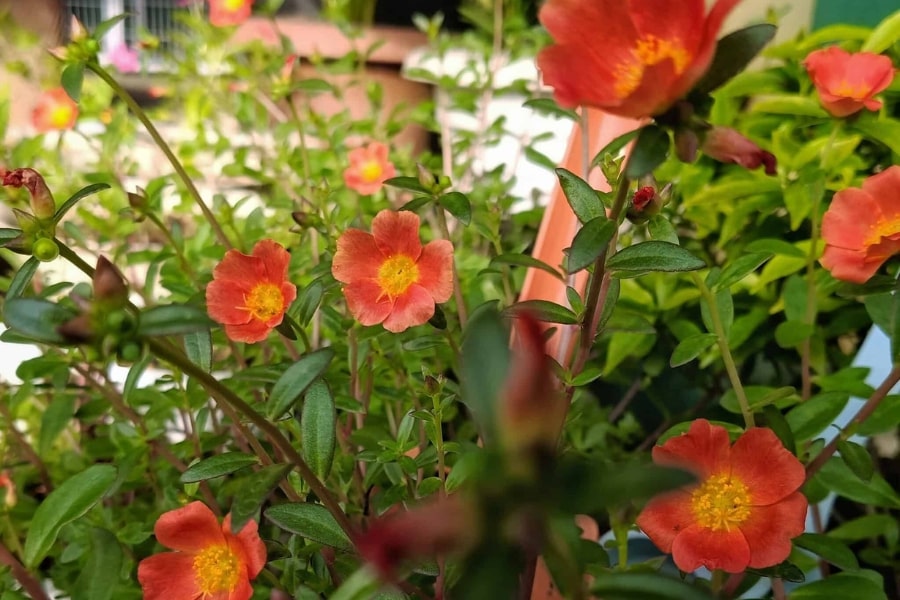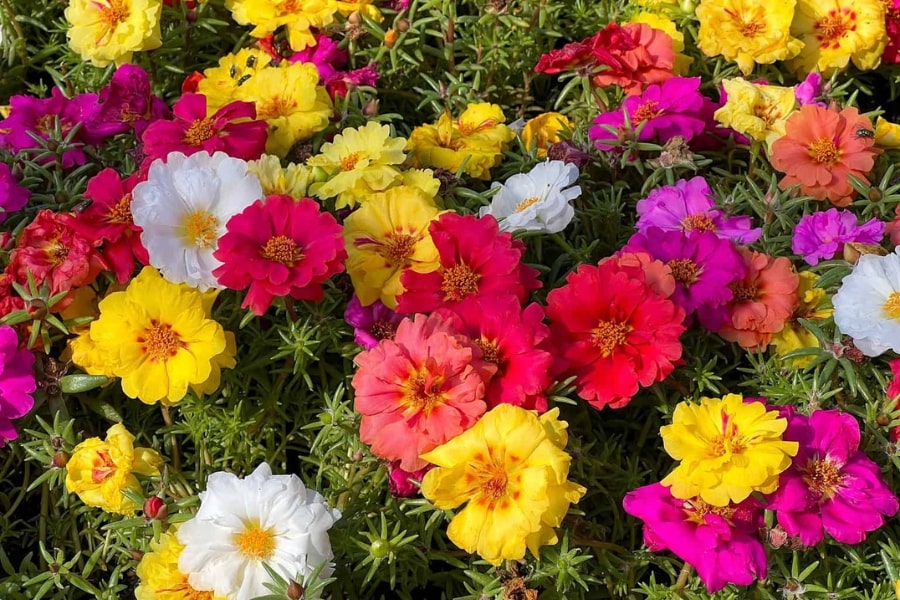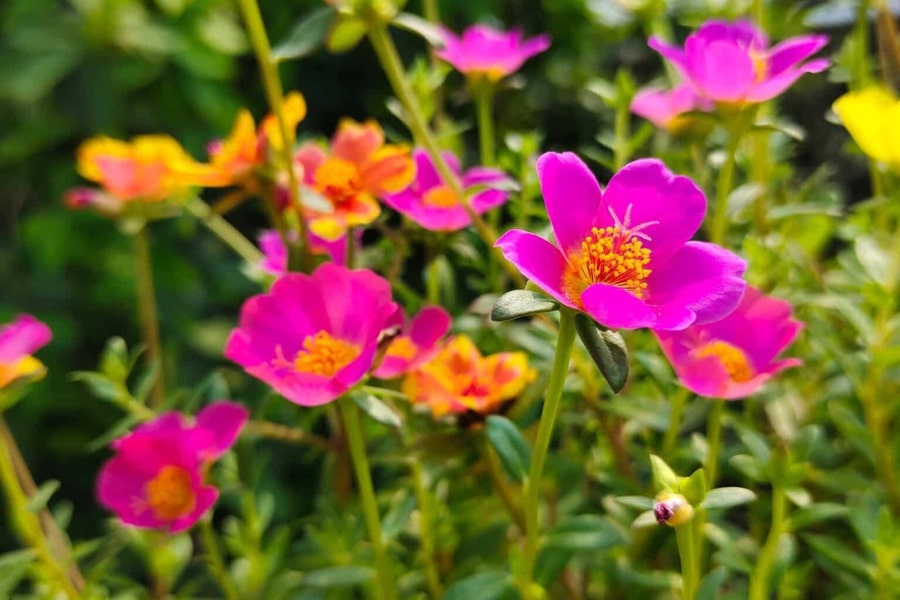Portulaca, also known as Purslane or Moss Rose, is an annual plant known for its bright and colorful blooms. It is commonly used as a colorful ground cover or a trailing plant in hanging baskets and containers. Portulaca can thrive in hot and dry conditions, making them an excellent choice for drought-tolerant gardens. The plant typically reaches a height of 4 to 8 inches and spreads up to 12 to 24 inches wide. Its compact nature and trailing habit lend themselves well to creating eye-catching displays.

Our Selection Of Portulaca
At Martin Garden Center, we grow several varieties from the Samba, Pazzaz, and Colorblast series in 4″ containers, and some are even converted into 10″ hanging baskets. In addition, we source the Portulaca Happy Hour upright variety in flats from a dedicated vendor, ensuring a diverse selection for our customers.
We are growing the following varieties in 2025:
- Duna Colorblast Double Guava
- Duna Colorblast Double Magenta
- Mega Pazzaz Mango Twist
- Samba Pink Bicolor
- Samba Rose
Portulaca becomes available in early April, and we stock a full table—about 150 plants in total—with availability tapering by mid-May, though these plants typically remain available through the end of summer. While we strive to keep the flats stocked, our reliance on a single vendor often results in them selling out by early May. Meanwhile, our Portulaca hanging baskets are extremely popular because, as succulents, they withstand high temperatures and extreme dryness far better than other hanging baskets, making them an ideal choice for full-sun areas throughout spring and summer.
Growing and Caring For Portulaca
Portulaca is a low-maintenance plant that thrives in hot and sunny conditions. Make sure to plant them in a sunny location that receives at least 6 to 8 hours of direct sunlight each day. These drought-tolerant plants prefer well-draining soil with sandy or gravelly texture. Water the plants sparingly, allowing the soil to dry out between watering sessions. Fertilizer application is generally unnecessary, as excessive nutrients can lead to excessive foliage growth at the expense of flowers. Deadheading spent blooms will encourage continuous flowering and maintain the plant’s neat appearance.
Portulaca does not tend to be susceptible to pests or diseases. The only issue of concern with Portulaca is overwatering, which will cause root rot and plant death. Allow soil to dry almost completely between waterings to prevent this issue.

Leaves and Flowers
Portulaca showcases petite, succulent leaves that are cylindrical or needle-like, creating a delightful texture. These leaves often form dense, low-growing mats or trailing vines, making Portulaca an excellent choice for ground cover or cascading from hanging baskets.
The plant starts to bloom in mid to late summer, and the flowers will continue to bloom until the first frost. The flowers are small and cup-shaped and bloom in shades of pink, red, orange, yellow, white, and various bi-color combinations. The flowers are typically about an inch in diameter and have a delicate, papery texture. Portulaca flowers are unique because they open during the day and close at night, earning them the common name “moss rose.” Deadheading or removing spent flowers can encourage more blooms and help maintain a tidy appearance.

Uses in the Garden
Portulaca thrives in hot, dry conditions, making it an excellent choice for drought-tolerant gardens. Its trailing habit and bright, rose-like blooms make it perfect for rock gardens, edging pathways, and filling in gaps between stepping stones. Portulaca also excels in hanging baskets and container gardens, where its trailing stems spill beautifully over the edges, creating a lush, cascading effect. Because it flourishes in sandy or poor soils, it’s ideal for xeriscaping and coastal gardens, bringing reliable color with minimal water requirements.
Beyond its resilience, Portulaca is highly valued for its long-lasting blooms, which open in full sun and provide continuous color from late spring through fall. It pairs well with other heat-loving plants like lantana, sedum, and calibrachoa, adding texture and vibrancy to mixed plantings. Portulaca’s succulent-like foliage helps retain moisture, reducing the need for frequent watering and making it a great low-maintenance option.

Frequently Asked Questions
Is Portulaca an Annual or Perennial?
Portulaca is typically grown as an annual in most regions, including the Upstate. Portulaca is not frost-tolerant and is cultivated for its vibrant and low-growing flowers during the warm months.
What To Plant With Portulaca In A Container?
Portulaca, also known as moss rose, has a trailing habit and produces colorful flowers, making it an excellent choice for container gardening. When planting Portulaca in a container, you can complement it with other plants with similar growing requirements and provide contrasting colors, textures, and heights to create an attractive display. Here are some plant companions that pair well with Portulaca in a container:
- Also known as Million Bells, Calibrachoa produces small, trumpet-shaped flowers in various colors. It complements Portulaca’s trailing habit and adds additional color to the container.
- Verbena produces clusters of small, brightly colored flowers and is available in various heights and colors. It can provide a vertical element to the container and contrast nicely with Portulaca’s low-growing habit.
- Lantana is a heat-tolerant plant that produces clusters of tiny flowers in vibrant colors. It attracts butterflies and hummingbirds and pairs well with Portulaca in containers.
- Dusty Miller has silvery-gray foliage that contrasts the bright flowers of Portulaca. It adds texture and visual interest to the container.
- Sweet Potato Vine is prized for its colorful foliage, which comes in shades of green, purple, and chartreuse. It can spill over the container’s edges, complementing Portulaca’s trailing habit.
- Zinnias produce large, showy flowers in a wide range of colors and heights. They add a bold splash of color to the container and attract pollinators like butterflies and bees.
- Creeping Jenny has vibrant green foliage that spills over the edges of the container, creating a cascading effect. It contrasts nicely with the colorful flowers of Portulaca.
Do Deer Eat Portulaca?
Portulaca is considered deer-resistant, as its succulent foliage has a bitter taste that is not appealing to deer. While no plant can be completely deer-proof, Portulaca is less likely to be a target for deer browsing.
Is Portulaca Edible?
Certain varieties of Portulaca, commonly known as purslane (Portulaca oleracea), are edible and have been consumed as a culinary plant in various cultures. Purslane is a succulent plant rich in omega-3 fatty acids, vitamins, and minerals. The leaves, stems, and flowers of purslane are all edible and have a slightly tangy or lemony flavor.
Do Hummingbirds Like Portulaca?
Hummingbirds are primarily attracted to tubular flowers containing nectar, their primary food source. While portulaca, also known as moss rose, doesn’t have tubular flowers like those preferred by hummingbirds, it can still attract them to some extent. Portulaca produces small, colorful flowers that are rich in nectar. While these flowers may not be as well-suited to hummingbirds as tubular flowers, they can still provide a food source, especially in areas where other nectar-rich flowers are scarce.
